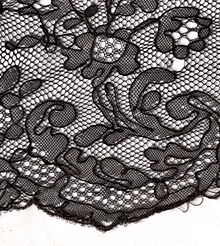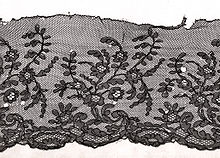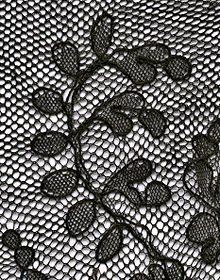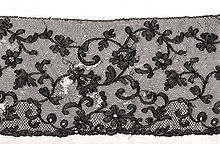- Chantilly lace
-
This article is about the type of lace. For the song, see Chantilly Lace (song). For the film, see Chantilly Lace (film).
Chantilly lace is a handmade bobbin lace named after the city of Chantilly,[1] France, in a tradition dating from the 17th century,[2][3] though the most famous are silk laces introduced in the 18th century. Though called Chantilly lace, most of the lace bearing this name was actually made in Bayeux in France and Geraardsbergen, now in Belgium.[4][5][6]
Chantilly lace is known for its fine ground, outlined pattern,[1] and abundant detail.[3] The pattern is outlined in cordonnet, a flat untwisted strand.[4][5][7] The best Chantilly laces were made of silk, and were generally black,[8] which made them suitable for mourning wear. White Chantilly lace was also made, both in linen and silk,[8] though most Chantilly laces were made of silk.[3] The black silk Chantilly lace became especially popular,[3] and there was a large market for it in Spain and the Americas. Chantilly and the Spanish laces (such as Blonde lace) were the most popular black laces. Little white Chantilly was ever {?}made.[6] Another notable thing about Chantilly lace is the use of a half-and-whole stitch as a fill to achieve the effect of light and shadow in the pattern,[3][6] which was generally of flowers. The background, or réseau, was in the form of a six pointed star,[5] and was made of the same thread as the pattern, unlike the otherwise similar Blonde lace.[7] The lace was produced in strips approximately four inches wide, and then joined with a stitch that left no visible seam.[3][4]
Chantilly lace remained popular in the 19th century, when every fashionable lady had a black or white Chantilly shawl, made in Brussels or Ghent.[1]
Contents
History
In the 17th century, the Duchesse de Longueville organised the manufacture of lace at Chantilly.[2] It has been produced from then up until the present day.[3] Owing to the patronage of the duchesse, and the proximity of Chantilly to Paris it became popular.[2] It came into fashion again during the reigns of Louis XV and Louis XVI,[7] and was an especial favorite of Louis XV's last mistress, Mme du Barry, and of Marie Antoinette.[6] When the French Revolution began in 1789, demand for the lace ceased. The lace-makers were seen as protégés of the royals, and after Mme du Barry and Marie Antoinette were guillotined in 1793, the lace-makers of Chantilly were themselves killed.[2][6] At this point production ceased.[6]
Napoleon I sponsored revivals of Chantilly lace,[2] most especially between the years 1804 and 1815.[6] At this point production was concentrated in Normandy, mainly around the Bayeux area. While it was no longer being made in Chantilly, all of the old techniques and designs were used.[6] Chantilly lace reached the height of its popularity around 1830[7] and was revived again in the 1860s, at which point it was made at Bayeux, but also at Geraardsbergen in Belgium.[6]
In 1844 a machine was patented that made Valenciennes lace and black silk Chantilly lace that was difficult to distinguish from the handmade lace.[9]
See also
References
- ^ a b c "Chantilly" The Oxford English Dictionary. 2nd ed. 1989.
- ^ a b c d e Sharp, Mary (March 2007). Point and Pillow Lace. Herron Press. p. 117. ISBN 1406745626. http://books.google.com/books?id=SjVqcPZF30cC&pg=PA105&dq=Valenciennes+lace&lr=&as_brr=3&client=opera&sig=UqxXFStcLAd6tp7iRcZlt4xTr9s. Retrieved 2008-05-10.
- ^ a b c d e f g Raffel, Marta Cotterell (January 2003). The Laces of Ipswich: The Art and Economics of an Early American Industry, 1750-1840. UPNE. p. 151. ISBN 1584651636. http://books.google.es/books?id=taavyQa65oAC&pg=PA151&dq=chantilly+lace&lr=&as_brr=3&client=firefox-a&hl=en&sig=QrB-62MM2Hq_3EDUw-NmKjBjMVw. Retrieved 2008-05-13.
- ^ a b c Powys, Marian (March 2002). Lace and Lace Making. Dover Publications. p. 31. ISBN 0486418111. http://books.google.com/books?id=2G1sifycRUAC&pg=PA3&dq=making+Valenciennes+lace&lr=&as_brr=3&client=opera&sig=dmJ3lVQ2-d1avX25IA41pBPWuyU. Retrieved 2008-05-14.
- ^ a b c Sharp, Mary (March 2007). Point and Pillow Lace. Herron Press. p. 114. ISBN 1406745626. http://books.google.com/books?id=SjVqcPZF30cC&pg=PA105&dq=Valenciennes+lace&lr=&as_brr=3&client=opera&sig=UqxXFStcLAd6tp7iRcZlt4xTr9s. Retrieved 2008-05-14.
- ^ a b c d e f g h i Earnshaw, Pat (February 1999). A Dictionary of Lace. Dover. p. 31. ISBN 048640482X. http://books.google.es/books?id=mjYWZ2mogv8C&pg=PA178&dq=chantilly+lace&lr=&as_brr=3&client=firefox-a&hl=en&sig=rabMj_-4qTTT-QEWrafKoJWdd-s#PPA31,M1. Retrieved 2008-05-13.
- ^ a b c d Blum, Clara M. (June 2002). Old World Lace: A Concise Illustrated Guide. Dover. p. 64. ISBN 0486421503. http://books.google.es/books?id=bh1MYkEzpJUC&pg=PA65&dq=chantilly+lace&lr=&as_brr=3&client=firefox-a&hl=en&sig=tvR635mj2IO3vuwJqsGg2gQS1zw#PPA67,M1. Retrieved 2008-05-13.
- ^ a b Powys, Marian (March 2002). Lace and Lace Making. Dover Publications. p. 28. ISBN 0486418111. http://books.google.com/books?id=2G1sifycRUAC&pg=PA3&dq=making+Valenciennes+lace&lr=&as_brr=3&client=opera&sig=dmJ3lVQ2-d1avX25IA41pBPWuyU. Retrieved 2008-05-14.
- ^ Felkin, William (1867). A History of the Machine-wrought Hosiery and Lace Manufactures. Longmans, Green and Co.. http://books.google.es/books?id=7SpDAAAAIAAJ&pg=PA415&dq=chantilly+lace&lr=&as_brr=3&client=firefox-a&hl=en#PPA419,M1. Retrieved 2008-05-14.
External links
Lace types Needle lace Punto in Aria · Point de Venise · Point de France · Alençon · Argentan · Argentella · Armenian · Hollie Point · Halas lace · Point de Gaze · Youghal · Kenmare Lace · Limerick
Embroidered: Reticella · Buratto · Filet/Lacis · Ñandutí · Needlerun net · Tambour · Teneriffe
Cutwork: Battenberg · Broderie Anglaise · Carrickmacross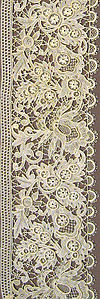
Bobbin lace Ancient: Antwerp · Ecclesiastical · Freehand · Torchon
Continental: Binche · Flanders · Mechlin · Paris · Valenciennes
Point ground: Bayeux · Blonde · Bucks point · Chantilly · Tønder · Beveren · Lille
Guipure: Genoese · Venetian · Bedfordshire · Cluny · Maltese
Part laces: Honiton · Bruges · Brussels
Tape: Milanese · Flemish · Russian · PeasantTape lace Mezzopunto · Princess · Renaissance · Romanian pointKnotted lace Crocheted lace Lace knitting Machine-made lace Categories:- Lace
- History of the textile industry
- History of clothing (Western fashion)
- History of clothing (Europe)
- Textile arts of France
Wikimedia Foundation. 2010.

